Related Research Articles
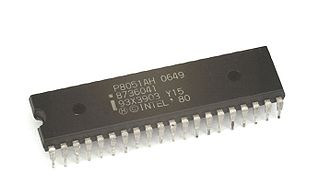
The Intel MCS-51 is a single chip microcontroller (MCU) series developed by Intel in 1980 for use in embedded systems. The architect of the Intel MCS-51 instruction set was John H. Wharton. Intel's original versions were popular in the 1980s and early 1990s, and enhanced binary compatible derivatives remain popular today. It is a complex instruction set computer, but also has some of the features of RISC architectures, such as a large register set and register windows, and has separate memory spaces for program instructions and data.
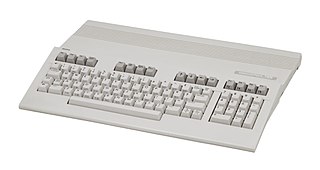
The Commodore 128, also known as the C128, C-128, or C= 128, is the last 8-bit home computer that was commercially released by Commodore Business Machines (CBM). Introduced in January 1985 at the CES in Las Vegas, it appeared three years after its predecessor, the Commodore 64, the bestselling computer of the 1980s. Approximately 2.5 million C128s were sold during its four year production run.

The Commodore Plus/4 is a home computer released by Commodore International in 1984. The "Plus/4" name refers to the four-application ROM-resident office suite ; it was billed as "the productivity computer with software built in".
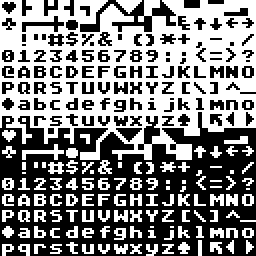
The ATASCII character set, from ATARI Standard Code for Information Interchange, alternatively ATARI ASCII, is a character encoding used in the Atari 8-bit family of home computers. ATASCII is based on ASCII, but is not fully compatible with it.

The Enterprise is a Zilog Z80-based home computer announced in 1983, but due to a series of delays, was not commercially available until 1985. It was developed by British company Intelligent Software and marketed by Enterprise Computers.
Addressing modes are an aspect of the instruction set architecture in most central processing unit (CPU) designs. The various addressing modes that are defined in a given instruction set architecture define how the machine language instructions in that architecture identify the operand(s) of each instruction. An addressing mode specifies how to calculate the effective memory address of an operand by using information held in registers and/or constants contained within a machine instruction or elsewhere.
Timeworks Publisher was a desktop publishing (DTP) program produced by GST Software in the United Kingdom and published by Timeworks, Inc., in the United States.

GEOS is a discontinued operating system from Berkeley Softworks. Originally designed for the Commodore 64 with its version being released in 1986, enhanced versions of GEOS later became available in 1987 for the Commodore 128 and in 1988 for the Apple II series of computers. A lesser-known version was also released for the Commodore Plus/4.
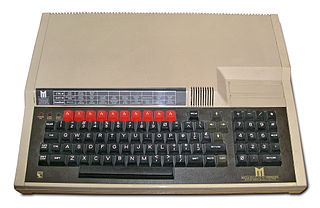
The BBC Master is a home computer released by Acorn Computers in early 1986. It was designed and built for the British Broadcasting Corporation (BBC) and was the successor to the BBC Micro Model B. The Master 128 remained in production until 1993.

PaperClip is a word processor for the Commodore 64, 128, and Atari 8-bit family published by Batteries Included in 1985. In the United Kingdom it was published by Ariolasoft.

SpeedScript is a word processor originally printed as a type-in MLX machine language listing in 1984-85 issues of Compute! and Compute!'s Gazette magazines. Approximately 5 KB in length, it provided many of the same features as commercial word processing packages of the 8-bit era, such as PaperClip and Bank Street Writer. Versions were published for the Apple II, Commodore 64 and 128, Atari 8-bit family, VIC-20, and MS-DOS.
The program status word (PSW) is a register that performs the function of a status register and program counter, and sometimes more. The term is also applied to a copy of the PSW in storage. This article only discusses the PSW in the IBM System/360 and its successors, and follows the IBM convention of numbering bits starting with 0 as the leftmost bit.

Microsoft Write is a basic word processor included with Windows 1.0 and later, until Windows NT 3.51. Throughout its lifespan it was minimally updated, and is comparable to early versions of MacWrite. Early versions of Write only work with Write Document (.wri) files, which are a subset of the Rich Text Format (RTF). After Windows 3.0, Write became capable of reading and composing early Word Document (.doc) files. With Windows 3.1, Write became OLE capable. In Windows 95, Write was replaced with WordPad; attempting to open Write from the Windows folder will open WordPad instead.
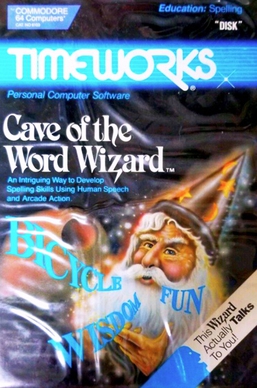
Cave of the Word Wizard is a 1982 educational children's game released for the Commodore 64 by Timeworks, Inc. It is designed to teach spelling.
GST was a group of computer companies based in Cambridge, England, founded by Jeff Fenton in June 1979. The company worked with Atari, Sinclair Research, Torch Computers, Acorn Computers, Monotype Corporation and Kwik-Fit, amongst others.
ST Writer is a word processor program for the Atari ST series of personal computers. It was introduced by Atari Corporation in 1985 along with the 520ST, the first machine in the ST family. It is a port of Atari's AtariWriter Plus from the earlier 8-bit computer series, matching it closely enough to share files across platforms unchanged. Running on the ST allowed it to display a full 80-column layout, create much larger files, and support additional features.
S3 is a structured, imperative high-level computer programming language. It was developed by the UK company International Computers Limited (ICL) for its 2900 Series mainframes. It is a system programming language with syntax influenced by ALGOL 68 but with data types and operators aligned to those offered by the 2900 Series. It was the implementation language of the operating system VME.

1st Word is a word processor program for the Atari ST developed by GST Computer Systems and published in 1985. It was given away with all ST systems from December 1985 for the next two years. Although it was relatively well received, it was a very simple program, lacking most power features and was very slow when working in large documents. In spite of any limitations, its wide availability made the program's .DOC file format became a de facto standard for the platform and was widely supported by other programs like desktop publishing systems.
The Commodore 1351 is a computer mouse made by Commodore in 1986, which can be directly plugged into the 9-pin control port of a Commodore 64 or 128.
Timeworks, Inc., later Timeworks International, Inc., was a private American software publisher active from 1982 to 1994 and based in Chicago, Illinois. The company primarily sold entry-level productivity software, as well as advanced desktop publishing applications and video games. They are perhaps best known for Publisher, their flagship desktop publishing application. In 1993, they were acquired by Megalode Resources, Inc., of Burlington, Ontario, who operated the company until 1994.